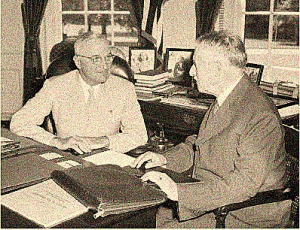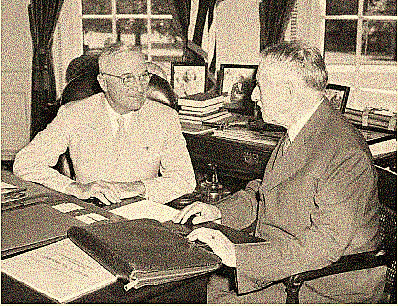Cross-posted from Scramble for Africa .

Harry Truman and Secretary of War Henry Stimson in the lull between the storms of Hiroshima and Nagasaki.
On August 6th 1945 Washington dropped the world’s first atomic bomb on Hiroshima. One hundred fifty thousand civilians were incinerated or condemned to slow and terrible deaths by radiation exposure (as immortalized in the Japanese manga and animated film Barefoot Gen). On August 9th, the Truman Administration released a plutonium core atomic bomb over Nagasaki, killing an additional 75,000 people.
A justifying mythology was immediately crafted and remains firmly lodged in popular understanding — at least in the U.S. The bombs were dropped, reluctantly, to save the lives of U.S. servicemen fighting Japan. Perhaps a half million (Truman’s claim) would have died before Japan would have unconditionally surrendered had the U.S. not deployed the bombs. The story has long been debunked, but with little popularization. If fact, Japan was already prepared to surrender, having only a few (trivial next to hundreds of thousands of lives) conditions. The actual reasons the bomb was dropped, included, as Gar Alperovitz has long argued, intimidating Russia and to demonstrate U.S. power on the world stage. Any street gangster would recognize the dynamic. There was also a concern to forestall any further Soviet influence in Asia. Thus the motive was political and the target was civilian. It is a textbook case of terrorism. Perhaps the preeminent example.
Truman’s successor continued developing the arsenal. In 1954, the federal government, in a secret test, detonated a thermonuclear hydrogen bomb — the most powerful device the country ever exploded — on the Bikini Atoll island range in the Pacific Ocean. Rongelap Atoll, in the Marshall Islands, was downwind. The people were temporarily relocated, only to be sent back a few years later to their now radioactive homelands.
The documentary Nuclear Savage: The Islands of Secret Project 4. 1 (a deeply moving preview is available online here) exhumes the history of the episode.
“In 1957,” Barbara Rose Johnston writes,
“the people of Rongelap were returned to their homelands with great fanfare, moving into newly built homes on islands still dangerously contaminated from prior nuclear weapons tests and clearly vulnerable to the fallout from the 33 bombs detonated in 1958. This repatriation of the Rongelap community was both planned and celebrated by scientists and officials at the US Department of Defense and the Atomic Energy Commission, who saw a significant opportunity to place a human population in a controlled setting to document how radiation moves through the food chain and human body. Annually, and then as the years progressed and degenerative health symptoms increased, biannually, the US medical teams visited by ship to examine, with x-ray, photos, blood, urine and tissue samples, the relative health of the community.”
In the documentary, footage from the era plays — “these are fishing people,” announces a narrator in the inimitable timbre of broadcasters of the era, “savages by our standards”. Such was the condescension of the powerful and the damned.
The mayor of Rongelap is introduced as “a savage, but a happy amenable savage.” He later developed thyroid cancer. As did his daughter. And then a grandson. Two of his sons also grew cancers. Another died of leukemia. The title of the film is an appropriate double entendre indeed.
The subtitle references the U.S. government medical study of the incident, which, as Johnston explains, “documented the array of health outcomes from their acute exposures, but did not treat the pain or discomfort of radiation burns, nor utilize antibiotics to offset any potential infection.”
A woman recounts how her first child was born without bones and “looked like a jellyfish.” Washington continues to maintain that the radiation fallout was an accident. It is not enough to suffer the blast. One must be insulted with such denials as well.
Unlike, Truman, the Eisenhower Administration had no terrorist motive. Theirs was purely a scientific experiment. They wanted to see how impressive their new weapon was. What would be the effect on humans? Best to find out on humans that did not matter. The people of the Marshall Islands were no more significant than lab mice. Though the Nazis had been defeated a decade earlier, the fascination with barbarous science, complete with Nuremburg Code violations, had evidently not been entirely quelled. Rongelap became an island of Dr. Moreau for the nuclear age.
There were plenty of remote corners of the world where Washington’s dark sciences could have been conducted far from human populations. The location was chosen precisely because there were homosapien unpeople inhabiting the area. Ordinary terrorism seems rather noble by comparison with the cynical motivations of Eisenhower’s grand secret experiment.
Subsequently, and to the species’ great fortune, no other nation has ever had the audacity to follow suit. The U.S. record remains blissfully unchallenged.
Along with Kevin Funk, Steven Fake is the author of “Scramble for Africa: Darfur – Intervention and the USA” (Black Rose Books). They maintain a website with their commentary at scrambleforafrica.org.

